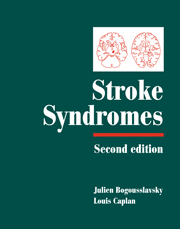Book contents
- Frontmatter
- Contents
- List of contributors
- Preface
- PART I CLINICAL MANIFESTATIONS
- PART II VASCULAR TOPOGRAPHIC SYNDROMES
- 29 Arterial territories of human brain
- 30 Superficial middle cerebral artery syndromes
- 31 Lenticulostriate arteries
- 32 Anterior cerebral artery
- 33 Anterior choroidal artery territory infarcts
- 34 Thalamic infarcts and hemorrhages
- 35 Caudate infarcts and hemorrhages
- 36 Posterior cerebral artery
- 37 Large and panhemispheric infarcts
- 38 Multiple, multilevel and bihemispheric infarcts
- 39 Midbrain infarcts
- 40 Pontine infarcts and hemorrhages
- 41 Medullary infarcts and hemorrhages
- 42 Cerebellar stroke syndromes
- 43 Extended infarcts in the posterior circulation (brainstem/cerebellum)
- 44 Border zone infarcts
- 45 Classical lacunar syndromes
- 46 Putaminal hemorrhages
- 47 Lobar hemorrhages
- 48 Intraventricular hemorrhages
- 49 Subarachnoid hemorrhage syndromes
- 50 Brain venous thrombosis syndromes
- 51 Carotid occlusion syndromes
- 52 Cervical artery dissection syndromes
- 53 Syndromes related to large artery thromboembolism within the vertebrobasilar system
- 54 Spinal stroke syndromes
- Index
- Plate section
40 - Pontine infarcts and hemorrhages
from PART II - VASCULAR TOPOGRAPHIC SYNDROMES
Published online by Cambridge University Press: 17 May 2010
- Frontmatter
- Contents
- List of contributors
- Preface
- PART I CLINICAL MANIFESTATIONS
- PART II VASCULAR TOPOGRAPHIC SYNDROMES
- 29 Arterial territories of human brain
- 30 Superficial middle cerebral artery syndromes
- 31 Lenticulostriate arteries
- 32 Anterior cerebral artery
- 33 Anterior choroidal artery territory infarcts
- 34 Thalamic infarcts and hemorrhages
- 35 Caudate infarcts and hemorrhages
- 36 Posterior cerebral artery
- 37 Large and panhemispheric infarcts
- 38 Multiple, multilevel and bihemispheric infarcts
- 39 Midbrain infarcts
- 40 Pontine infarcts and hemorrhages
- 41 Medullary infarcts and hemorrhages
- 42 Cerebellar stroke syndromes
- 43 Extended infarcts in the posterior circulation (brainstem/cerebellum)
- 44 Border zone infarcts
- 45 Classical lacunar syndromes
- 46 Putaminal hemorrhages
- 47 Lobar hemorrhages
- 48 Intraventricular hemorrhages
- 49 Subarachnoid hemorrhage syndromes
- 50 Brain venous thrombosis syndromes
- 51 Carotid occlusion syndromes
- 52 Cervical artery dissection syndromes
- 53 Syndromes related to large artery thromboembolism within the vertebrobasilar system
- 54 Spinal stroke syndromes
- Index
- Plate section
Summary
Neurovascular anatomy of the pons
The anatomic distribution of the major pontine arteries was worked out by Duret (1873) and, later, Stopford (1915, 1916) and Foix and Hillemand (1925a,b). The arterial supply can be divided into three groups. (i) Paramedian arteries arising from the dorsal surface of the basilar artery penetrate the pons directly and are larger than the other penetrating vessels. They supply the medial portion of the basis pontis and the most ventral part of the tegmentum. (ii) Short circumferential arteries supply the lateral three- fifths of the pons. And (iii) long circumferential arteries nourish the lateral tegmentum and tectum. Short penetrators course more laterally and run parallel to the median arteries. Lateral penetrators arise from the long circumferential arteries, supply the lateral tegmentum, and run perpendicular to the median penetrators (Fig. 40.1).
According to a recent description of the arterial supply to the brainstem and cerebellum (Tatu et al., 1996), the pons is supplied by three groups of arteries: (i) anteromedial and anterolateral groups arising from the basilar artery, entering the foramen cecum, the basilar sulcus, and the interpeduncular fossa; (ii) lateral group arising from the AICA (entering the parenchyma in the pontomedullary sulcus and arising from the lateral pontine arteries (entering the brachium pontis); and (iii) posterior group arising from the superior cerebellar artery (medial and lateral branches).
- Type
- Chapter
- Information
- Stroke Syndromes , pp. 520 - 533Publisher: Cambridge University PressPrint publication year: 2001
- 3
- Cited by



